The Sutra of Tara Who Protects from the Eight Fears: in Tara’s Own Words
Tara’s vast popularity in Mahayana Buddhism — as both Bodhisattva and Buddha — is easy to understand. Not only is she a “Mother” — a mother deity and the “Mother of All Buddhas” — but she also protects us...
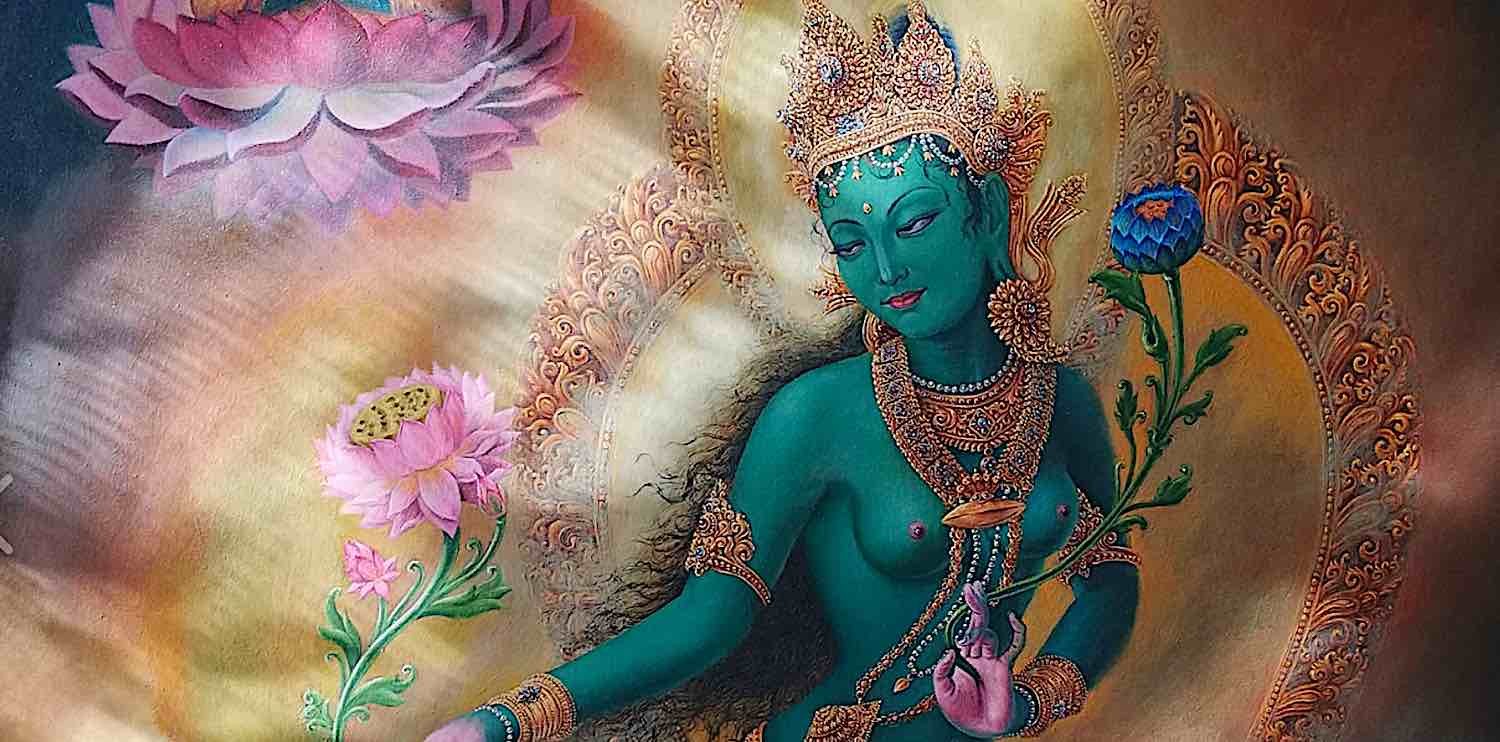

Tara’s vast popularity in Mahayana Buddhism — as both Bodhisattva and Buddha — is easy to understand. Not only is she a “Mother” — a mother deity and the “Mother of All Buddhas” — but she also protects us from the Eight Dangers or Fears, including diseases and epidemics.
How important is Tara? It was at Tara’s urging that the great Atisha left India to go to Tibet and brought the Dharma. It was Tara who challenged great Naropa with the question: “Do you understand the words or the sense?” The Mahsiddha Surya Gupta received teachings on the 21 Taras directly from Tara. The great Enlightened Padmasambhava himself brought Tara practice to Tibet. Countless Mahasiddhis and Yogis in India, Tibet and Nepal relied on Tara.
In other words, her practice is much more than mundane protection from dangers in our daily lives. (Although, to see Tara in action overcoming “attackers” see the beautiful painting below of the monk rescued by Tara from his attackers.)
NOTE: In this feature, we include the full English-Translated The Sutra of Tara Who Protects from the Eight Fears below along with the Great Dharani of Tara’s Sutra. For other features on Tara, please see our special feature section, with many other in-depth feature stories>>The Sutra of Tara Who Protects from the Eight Fears is important as a Sutra — Tara’s own beautiful, hopeful, evocative and powerful words.
As explained by Martin Wilson in his wonderful book In Praise of Tara:
“Tara’s beautiful sermon concisely presents this basic situation and outlines the levels of Dharma practice that lead out of it. Having made plain the futility of merely reciting mantras while one neglects to follow impeccably the conduct that must go with them, She delivers a Dharani that will help one’s practice if one uses it right.” [1]
 Green Tara. From a 18th century prayer “Longing for Tara”:
Green Tara. From a 18th century prayer “Longing for Tara”:“From my heart I bow to Divine Mother Tara, essence of love and compassion, the most precious objects of refuge gathered into one. From now until I reach enlightenment, hook me with your great love and kindness to liberate me.” Full prayer found in this feature>>
The Great Dharani of the Sutra of Tara
This Dharani is widely used in Buddhist practice:
OM NAMO ARYA-AVALOKITESVARAYA
BODHISATTVA
MAHASATTVA
MAHA- KARUNIKAYA
TADYATHA OM TARE TUTTARE TURE SARVA-DUSTAN
PRADUSTAN MAMA KRTE
DZAMBHAYA
STAMBHAYA
MOHAYA
BANDHAYA
HUM HUM HUM
PHAT PHAT PHAT SVAHA
MAMA ARYAVALOKABHAYA NARA
BODHISATTVA MAHASATTVANI
ADHISTHANA
ADHISTHITE MAMA SARVA-KARMA-AVARANA- SVAHBAVA
SUDDHE VISUDDHE
SHODHYAYA VISHODHAYA HUM PHAT SVAHA
There are also countless Tantras dedicated to Tara. This sutra is actually found in the Kangyur (which means, “Translation of the Word”) and is incredibly important to Tibetan Buddhists and Buddhists in Nepal and India.
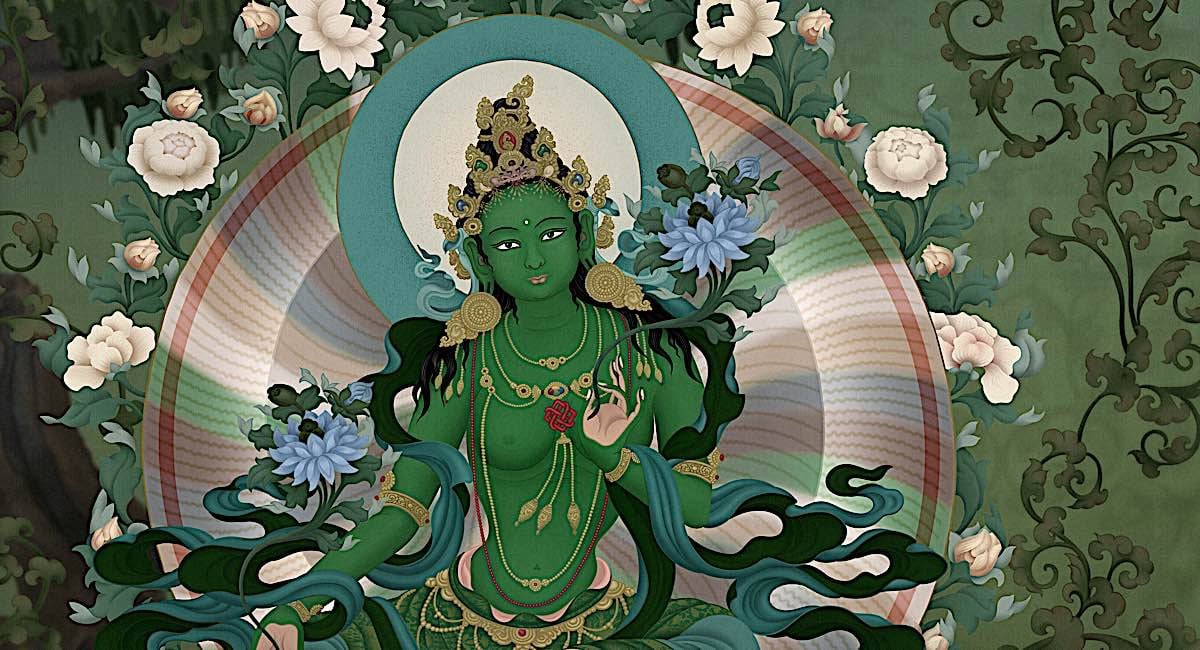 A cropped section of a stunning thangka by Jampay Dorje (Ben Christian). See this feature interview with this amazing artist in Buddha Weekly>>
A cropped section of a stunning thangka by Jampay Dorje (Ben Christian). See this feature interview with this amazing artist in Buddha Weekly>>
In this feature, we include the full English-Translated The Sutra of Tara Who Protects from the Eight Fears. Sutra recitation is a pre-eminent practice in Mahayana Buddhism. What better way to bring Tara’s protective Enlightened energy into your life than to recite her short sutra daily? Or, for those in a rush, the Great Dharani of the Tara Sutra (above.)
For other features on Tara, please see our special feature section, with many other in-depth feature stories>>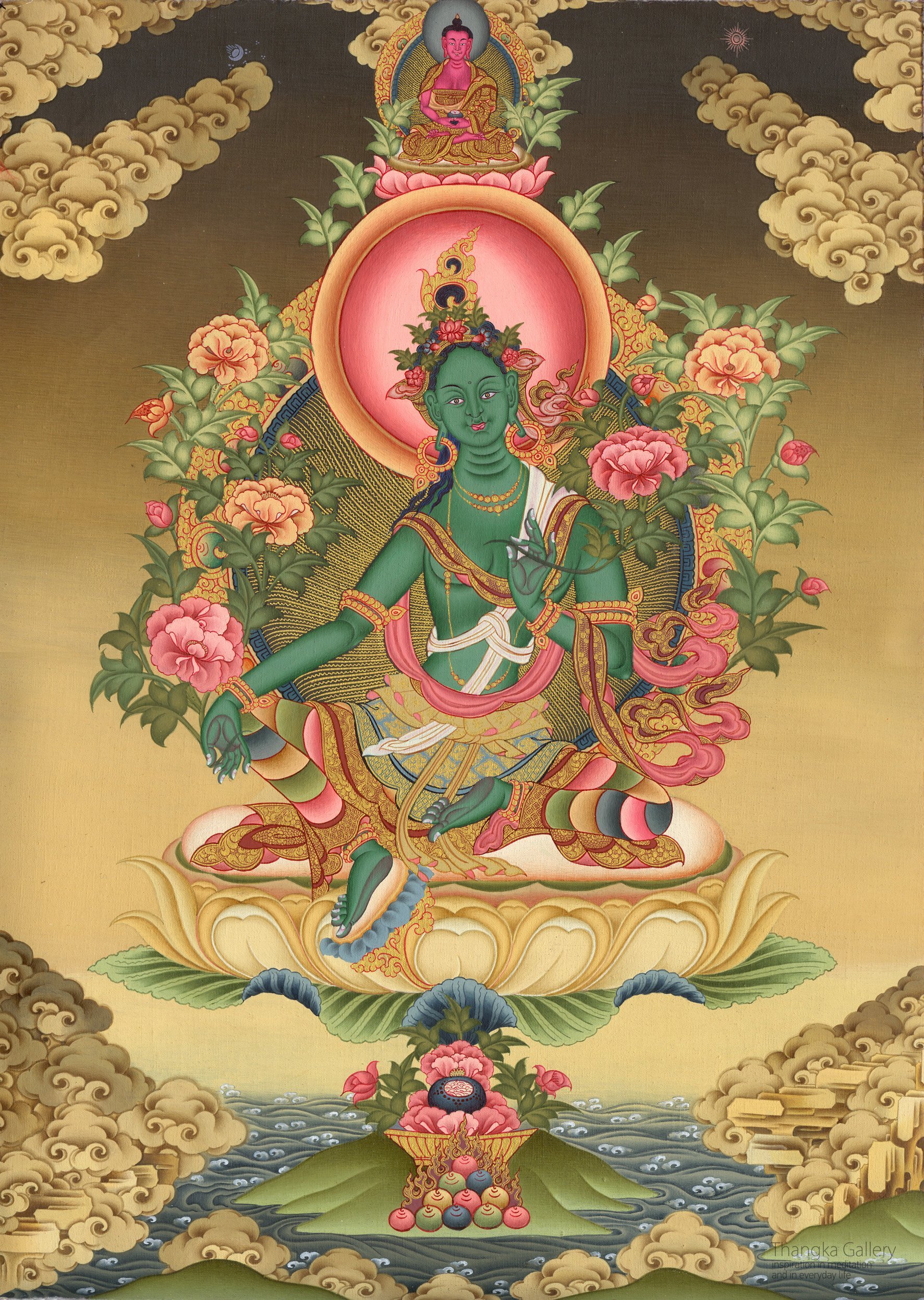 Green Tara on a lotus is visualized with one leg outstretched — ready to leap to the aid of people in trouble. Above her head is her own guru Amitabha Buddha.
Green Tara on a lotus is visualized with one leg outstretched — ready to leap to the aid of people in trouble. Above her head is her own guru Amitabha Buddha.
The Sutra of Tara — the Root of Her Popularity
The Sūtra of Tārā Who Protects from the Eight Fears (Skt. tārā ṣṭaghoratāraṇī sūtra, Tib. སྒྲོལ་མ་འཇིགས་པ་བརྒྱད་འཇིགས་པ་བརྒྱད་ལས་སྐྱོབ་པའི་མདོ་, drolma jikpa gyé jikpa gyé lé kyobpé do, Wyl. sgrol ma ‘jigs pa brgyad las skyob pa’i mdo) — is the root of Her popularity. Tibetan Buddhists around the world, by the millions, start their day with Tara practice.
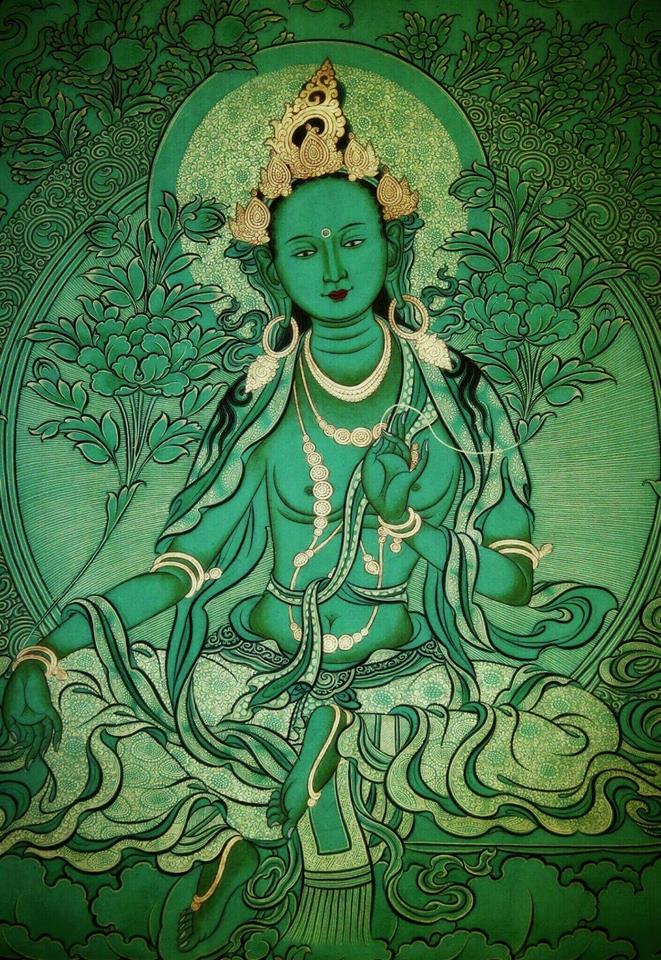
Hers is the first practice and mantra of the day. It’s easy to understand why. As we start a new day in danger-filled Samsara, what is more important than protection from our many fears? Think of it as breakfast with Mom. Nourished with the Dharma, and reassured that the Mother Buddha is on our side, we can get through our hectic day. The other reason Her practice comes first is we honour her by not eating meat. Since most of us cannot be full-time vegetarians, we “cheat” by remaining meat-free until after we meditate with Mother Tara. It’s the least we can do karmically. (And, for those who can stay meat-free, Tara smiles.)
Why fears are so important in Buddhism
Dangers and fears we understand instinctively in our mundane lives — but they are also the causes of our obstacles in our Mahayana Bodhisattva aspiration of Enlightenment for the benefit of all sentient beings. If we can overcome these fears and dangers, we can potentially achieve the goal of realizations.
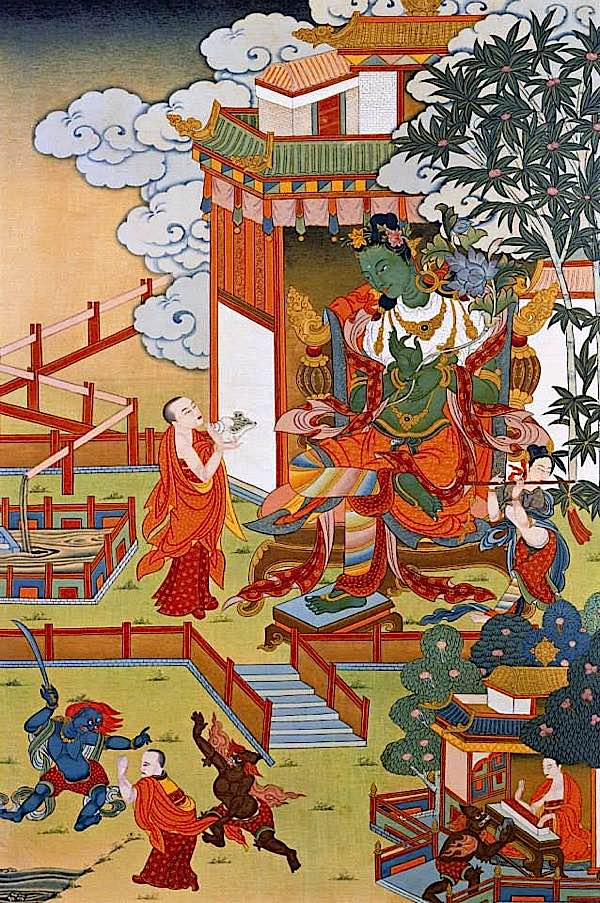 In this classical painting of Green Tara, she is shown rescuing a monk from attackers.
In this classical painting of Green Tara, she is shown rescuing a monk from attackers.
The Eight Fears are the causes of our suffering — and they are also what prevents our realizations. At some level all Buddhist practices — from renunciation through to Lamrim practices and on to Highest Yoga Tantra — all rely on removing our fears and obstacles.
This makes Tara so vital. All Bodhisattvas are compassionate. Tara Herself sprang symbolically from the tears of the World Lord Avalokiteshvara, the Compassionate Bodhisattva. She vowed to help him in his mission to free all suffering sentient beings from Samsara. She is, in fact, an emanation of the Great Lord Chenrezig. She is, as suggested by her green colour, the Activity of all the Buddha’s compassion. What is Her activity? Saving us from the Eight Dangers, the Eight Fears — which are to be understood on two levels: mundane fears and dangers, and the ultimate spiritual fears and dangers.
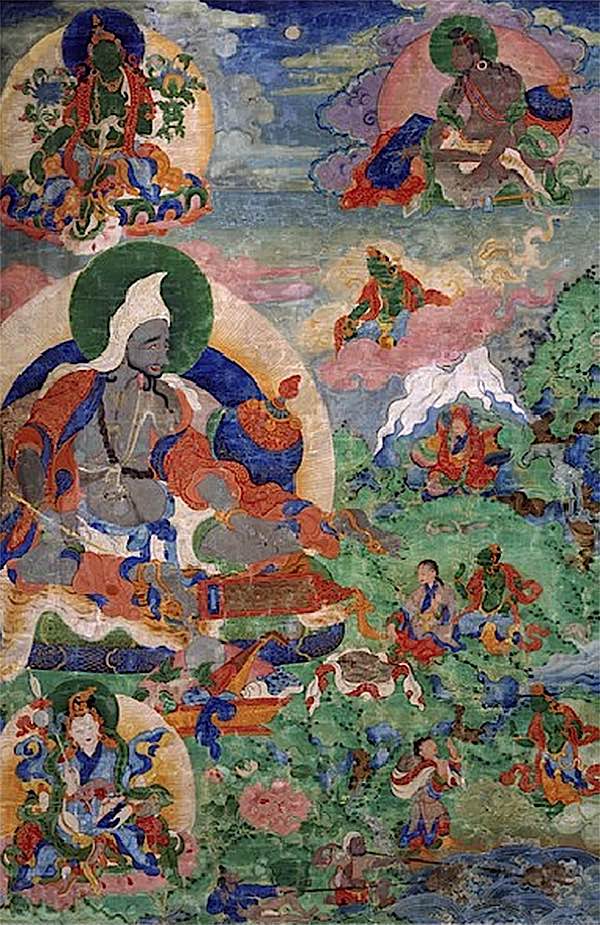 The Mahasiddha Surya Gupta and Taras.
The Mahasiddha Surya Gupta and Taras.
The Eight Fears, including Epidemic Diseases
In the Sutra, verse 26, the eight fears are listed:
“Protector from the eight dangers – Lions, elephants and fire,Serpents, robbers, water, plagues and demons [pisacas] – homage to You!”
These fears can certainly be taken as literal since protection is vital to our lives — and therefore our practice and our Mahayana mission — but they have a second layer of meanings. Lions can generally mean a wild animal. But it also means “pride.” Our own pride is the cause of many of our obstacles, the root of our ego issues. In commentaries, the eight fears conquered by Tara are aligned with our internal obstacles:
Lions represent “pride” Elephants stand for “ignorance” Fire is “anger” — one of the greatest obstacles to Dharma practice Serpents are “envy” Robbers are “wrong views” — the rob us of the opportunity to attain Enlightenment Water (often described as Floods) is “attachment” Plagues (disease) — in some Tantras it’s prison, but in the root Sutra it’s Plague or Epidemic — which stands for “avarice.” Demons (pisacas) [2] which is aligned with “doubt.”The translator of the Sutra, Martin Wilson comments:
“The function of Tara from which the Sutra takes its title is mentioned only in verse 26… The only difference from what is now a standard list is ‘plagues’ or epidemic diseases instead of prison.”
NOTE: Martin Wilson uses “pisacas” in his translation. I’ve changed to the more recognizable Demons” here (see note 2.) However, for recitation either is probably fine.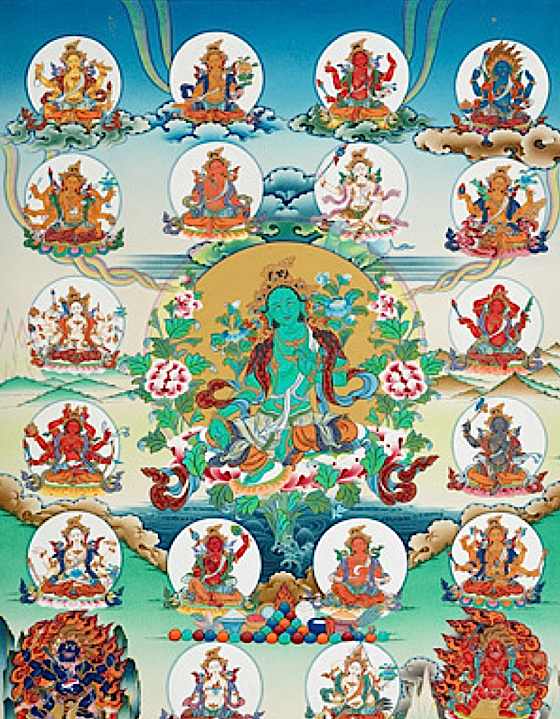 Thangka depicting Mother Tara and the 21 Taras according to the Surya Gupta tradition. For a feature story (three part super feature) on the 21 Taras according to Surya Gupta, see>>
Thangka depicting Mother Tara and the 21 Taras according to the Surya Gupta tradition. For a feature story (three part super feature) on the 21 Taras according to Surya Gupta, see>>
Arya’s own beautiful words
In the sutra Arya-Tara Who Saves from the Eight Fears we hear Her own magnificent words. The sutra records her teachings to a Divine Assembly.
THE SUTRA OF ARYA-TARA WHO SAVES FROM THE EIGHT FEARS
Homage to the Three Jewels! Homage to Venerable Tara! Homage to the Lord Shakyamuni!
Thus have I heard at one time. The lord was residing in the realm of the gods on Mount Meru. Among the assembly there, the Goddess Tara spoke, as follows.
Having reached this gem-like paradise, Understand actions and their results: Keep to good and leave evil aside!For whoever practices wrong actions Will, in the life that is to come, fall down. Beasts are dumb and stupid; one eats another;
Up weary paths, down cliffs, they climb and fall,
In panic, terror-stricken, trembling with fear,
Full of caution – one cannot conceive their sufferings. Pretas hunger and thirst, and their bodies won’t do. Should food or drink appear, another guards it,
Or if they eat some, it turns to fire or swords.
Their suffering of hunger and thirst can’t be conceived. Sentient beings who are born in hells
Are led against their will by vicious Yamas,
Burned and cooked and cut up with sharp weapons; Their suffering, hot or cold, cannot be borne. Therefore, doing wrong deeds in this life Manifests to oneself, magnified –
For many eons, fierce sorrow torments one With no time to escape, nor chance to bear it. Understand karmic effect by clear recollection. Unbearable suffering and lamentation torment one; Foul speech, fierce body and voice also frighten; These and other sufferings can’t be conceived. Those who, knowing thoroughly the faults, Abandon causes of the three realms of woe And in any gross or subtle sin
Never engage with body, speech and mind, But though happy themselves aid all migrators, Greed, hate, delusion gone, root of compassion
Firm, and striving with the three doors pure do virtue, Strive in this essence of the most profound. The fruit of a flower that frost has carried off, Though cultivated, will produce no sprout;
So too people who doubt and break their vows, Though they may practice most profound mantras, Might think a blessing comes, but it cannot – Their pains become but meaningless fatigue, Their mantras like the talk of common folk, Their concentrations but like childish thoughts. If people practice those mantras without fault,
Quickly they will accomplish what they wish.
For example, the seed of the banyan tree (nyagrodha) is tiny, But if well moistened with water and manure, In seven years it grows a league across;
If even external matter has such growth,
What of practicing consciousness with consciousness? Inner clear light’s growth is measureless. If, relying on traders who know the way,
With a suitable boat one puts to sea,
Then when one has found jewels as one wished, In due course one reaches one’s own home. With Bodhicitta, relying on Love, Compassion, Joy and Equanimity, practice virtue,
And set out on the Path of true perfection: You will reach the stage of certain knowledge. If an arrow, shot by a man, has flown,
Indeed it’s been shot, though one may think not. A person who’s realized all Reality’s meaning Goes beyond, although one may think not. Aspect and nature of actions and parts perfected, Without doubt he’ll gain the fruits of Buddhahood. If one understands that pure Reality (dharmata), There is no self, nor life, nor cutting of life, No karma, and no karmic ripening.
That person abandons extremes and is liberated. If to realize that benefit, you recite
Devotedly this essence I’m explaining, Sins of three countless eons will be consumed,
All sufferings of the three realms of woe and samsara Will be washed away, and obscurations cleared. This beneficial essence is as follows.
OM! Bodhisattva-mahasattva, Goddess! Please will you protect me!
OM NAMO ARYA-AVALOKITESVARAYA / BODHISATTVA / MAHASATTVA / MAHA- KARUNIKAYA / TADYATHA OM TARE TUTTARE TURE SARVA-DUSTAN / PRADUSTAN MAMA KRTE / DZAMBHAYA / STAMBHAYA / MOHAYA / BANDHAYA / HUM HUM HUM / PHAT PHAT PHAT SVAHA / MAMA ARYAVALOKABHAYA NARA / BODHISATTVA MAHASATTVANI / ADHISTHANA / ADHISTHITE MAMA SARVA-KARMA-AVARANA- SVAHBAVA / SUDDHE VISUDDHE / SHODHYAYA VISHODHAYA HUM PHAT SVAHA
Thereupon, by the Buddha’s power, Full praise was given to the Goddess: With very great CompassionYou work the weal of beings, Complete in Marks and Signs, Bedecked with jewel adornments, Your neck most beautiful, And smiling, laughing face! Your eye-sense-sphere is like flax-lotuses,
Your ear-sense-sphere like open uk-cho flowers, Your nose-sense-sphere like fragments of utpalas, Your mouth-sense-sphere like full-grown hollyhocks. Your Body, a lovely maiden’s has various forms;
Your Speech of kalavinka proclaims the Dharma;
Your Mind of compassion is all beings’ loving protector. Left, a lotus – unstained with samsara’s faults;
Right, giving Refuge, to benefit sentient beings;
You sit on sun and moon seats – Method and Wisdom. Venerable Tara, I go to You for Refuge. Protect me from samsara’s great abyss, Never to circle in the six migrations!
Hold me with Your cord of Great Compassion, Never to run to the three ill-destiny realms! Set me on a Path where I cannot stray, Never to be born with perverse views! Let me meet a Guru with Bodhicitta, Never meeting with evil companions! Protector from the eight dangers – Lions, elephants and fire,
Serpents, robbers, water, plagues and demons (pisacas)[2] – homage to You! In this life and in others, From the eight fears please protect me! Until I win the transcendent Result,
Let me keep inseparable company with
The ten Paramitas of Giving, Morality,
Patience, Energy, Dhyana, Wisdom, Means,
Vow and Power and likewise Wisdom – knowledge!
Any son or daughter of good family should write this teaching, read it, recite it, preserve it, practice right attention upon it, and extensively teach it to others.
Thus spoke [the Lord], and the whole assembly, enraptured, exalted [His word]. This completes the Sutra of Arya –Tara Who Saves from the Eight Fears.
For other features on Tara, please see our special feature section, with many other in-depth feature stories>>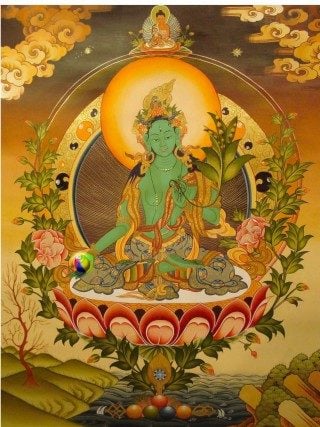 Green Tara on a lotus is visualized with one leg outstretched — ready to leap to the aid of people in trouble. Above her head is her own guru Amitabha Buddha.
Green Tara on a lotus is visualized with one leg outstretched — ready to leap to the aid of people in trouble. Above her head is her own guru Amitabha Buddha.
NOTES
[1] The Sutra of Arya-Tara found in Tibetan translation in the Tantra section of the Kangyur and is classified as a Kriya Tantra. The Sutra of Arya-Tara Who Saves From the Eight Fears, translated by Martin Willson, in In Praise of Tara: Songs to the Saviouress, published by Wisdom Publications, 1986, page 87-91
[2] Pishachas are flesh-eating demons in Hindu theology. Such theology describes them as the sons of either Krodha or as Dakṣa’s daughter Piśāca. They have been described to bulging veins and protruding, red eyes. They are believed to have their own languages, known as Paiśāci.

 FrankLin
FrankLin 























.jpeg)







